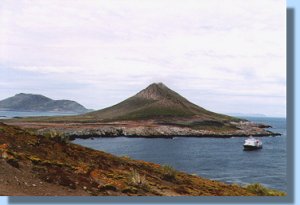 We're anchored opposite an isthmus separating the western and eastern part of
Steeple Jason. The eastern part of Steeple Jason is off limits to us because
the giant petrels nesting there are very easily disturbed. This could result
in their chicks being seized by striated caracaras. There's another reason to
remain at distance as well. Feeling threatened they may regurgitate the contents
of their stomach over a distance of a few meters. According to the experts (from
experience?) this regurgitated stuff smells badly, cannot be washed off and
lasts for several days!
We're anchored opposite an isthmus separating the western and eastern part of
Steeple Jason. The eastern part of Steeple Jason is off limits to us because
the giant petrels nesting there are very easily disturbed. This could result
in their chicks being seized by striated caracaras. There's another reason to
remain at distance as well. Feeling threatened they may regurgitate the contents
of their stomach over a distance of a few meters. According to the experts (from
experience?) this regurgitated stuff smells badly, cannot be washed off and
lasts for several days!
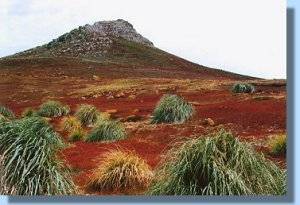
Instead we will visit the western part of Steeple Jason. At 8 in the morning the first zodiacs leave towards the shore. For the third day in a row the weather is cooperating and Steeple Jason is bathing in a soft morning light. The sea is calm and landing on the rocky shore of Steeple Jason is easy. Covered with bright patches of red weed and with barren peaks pointing skywards it reminds me of a combination of South Plaza and Bartholomé in the Galapagos.
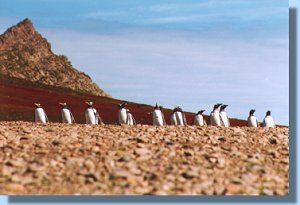
The landing on a rocky outcrop is easy. To the left the 263-meters high top bathes in sunlight. The base of it is covered in red alternated by green mossy areas and tussock grass.
A surprise unfolds before my eyes: outlined against the blue sky a group of gentoo penguins is standing. They alternate between a forward movement to the sea and a backward retreat when some of us make an unexpected movement.
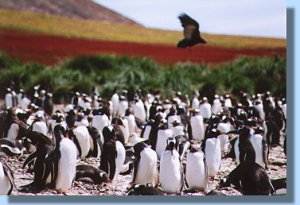
Just over the hill lies their colony consisting of a few hundred gentoos. Many are breeding. This is primary hunting ground for striated caracaras and many can be seen around the colony waiting for a chance to snatch a gentoo chick.
Striated caracaras have a bad reputation in the Falklands. They are curious and not easily scared. Every time we sit down putting our camera bags on the ground it's just a matter of seconds before a caracara lands within a few meters from us.
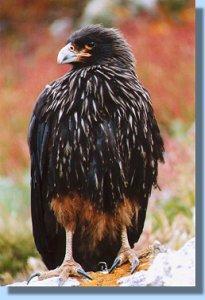
We watch them patrol around the outer edges of the colony harassing those gentoos that are unfortunate enough to have a nest here. At least two times we see a successful attack.
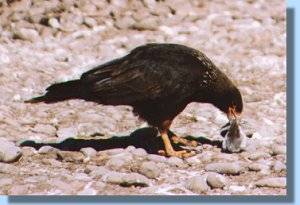 We are not safe either. One caracara succeeds in flying away with the expensive
binoculars of one of our fellow travelers.
We are not safe either. One caracara succeeds in flying away with the expensive
binoculars of one of our fellow travelers.
Frequently we see aggressive behavior between two gentoos. Accompanied by fierce flapping of their wings two penguins follow each other in a wild chase straight through the colony. Unfortunate penguins that are in the path of the pursuit are run over. The chases end as sudden as they start.
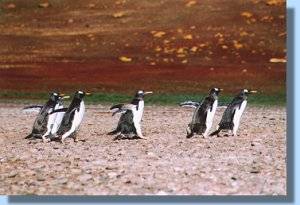 We also see gentoos collecting
pebbles to build a nest. It's especially funny to see a penguin carefully stealing
pebbles of a neighbor's nest for its own nest, the rightful owner being unable
to prevent this as it cannot leave its chick unprotected.
We also see gentoos collecting
pebbles to build a nest. It's especially funny to see a penguin carefully stealing
pebbles of a neighbor's nest for its own nest, the rightful owner being unable
to prevent this as it cannot leave its chick unprotected.
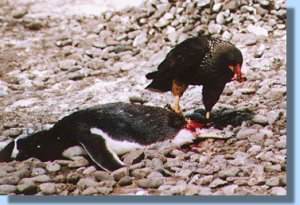
Just as we intend to leave the colony, a gentoo appears crawling out of a piece of tussock grass. A caracara takes its chance and starts pecking at the back of the gentoo. Although the gentoo remains alive for a while as indicated by an occasional flapping of its wing the caracara continues to tear pieces of flesh from the poor penguin's back. Soon many more caracaras arrive at the scene. Fighting and chasing each other they further devour the poor penguin.
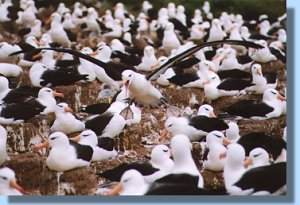
It's already noon and if we want to see the albatrosses as well we need to leave the gentoos. Close to the sea the surface is covered by tussock grass so we choose a route higher up the slope.
A half an hour's walk through red and green fields brings us to the beginning of the albatross colony. Tens of thousands of black-browed albatrosses nest here and the air is filled with albatrosses.
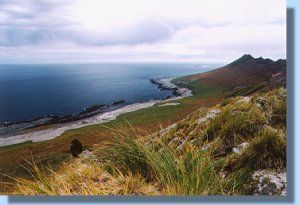
To get a better view on the colony I decide to climb the 263-meter high hill behind me. On my way up I'm warned for about 15 caracaras on the top. Frequently a curious caracara lands within a few meters from me but fortunately they don't attack. After a strenuous climb I safely reach the top. The view from above is gorgeous. The albatross colony indeed is enormous, the Polar Star is a tiny boat far below and the peak on the eastern part of Steeple Jason looks like a volcano as some cloud seems connected to its top.
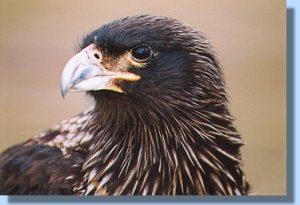
In the meantime a number of caracaras have surrounded me. One caracara hovers a meter above my head but instead of dive bombing it lands two meters in front of me. The others seem to be satisfied just looking at me. A few droplets of rain fall down and I decide it's time to go down again. As the slope is very steep and part of it is covered with loose grit I carefully climb down again. Without problems I reach the base of the hill again.
To get a closer look at the albatrosses we have to enter the tussock grass. Inside the chest high tussock grass the going isn't easy but we manage to get further and further towards the colony. A sudden bump against my head notifies me of a caracara that has decided I'm to close to its nest. Careful not to provoke a second attack we walk
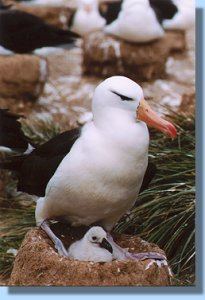 further until we reach the edge of the colony.
further until we reach the edge of the colony.
Here the albatrosses sit on a bowl shaped platform made of mud as well. But contrary to New Island many nests contain a chick only. Apparently they are big enough to be left alone while its parent are feeding.
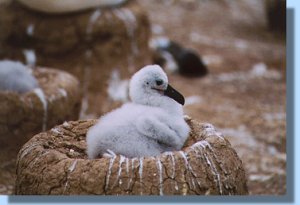 Albatrosses fill the air and several times we see one
landing inside the colony, its wings and webbed feet spread out to reduce speed.
After a while we have to go back and we disappear inside
the tussock grass again. We manage to avoid a few dive bomb attacks from
the same caracara and reach the open field again. Walking back we
accidentally get close to some petrels nests as is indicated by a few
petrels that dive towards us. Carefully not to disturb any other birds
we choose a different path towards the zodiacs.
Albatrosses fill the air and several times we see one
landing inside the colony, its wings and webbed feet spread out to reduce speed.
After a while we have to go back and we disappear inside
the tussock grass again. We manage to avoid a few dive bomb attacks from
the same caracara and reach the open field again. Walking back we
accidentally get close to some petrels nests as is indicated by a few
petrels that dive towards us. Carefully not to disturb any other birds
we choose a different path towards the zodiacs.
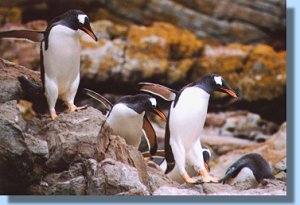
Waiting for the zodiac to bring us back to the ship we watch a large group of gentoos swimming around. After a while they decide it's time to approach the shore. Porpoising through the water they jump a shore and in a long line they hop over the rocks towards their colony. A little bit higher up the hill a few caracaras are taking a dust bath. Unwilling to leave we climb aboard of the last zodiac returning from Steeple Jason.
A message from the ship tells us we're missing somebody. While our zodiac travels around the island trying to spot this missing person somebody from the staff walks uphill. Far above the albatross colony we see her and forty-five minutes later we welcome her aboard the ship as well. Immediately afterwards the captain raises anchor for our 2 day's ocean crossing towards South Georgia.